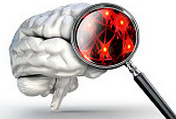Scientists discover link between loss of grey matter and negative schizophrenia symptoms
 There may be a link between the loss of brain grey matter tissue and the development of negative symptoms in people with schizophrenia, according to new research.
There may be a link between the loss of brain grey matter tissue and the development of negative symptoms in people with schizophrenia, according to new research.
Schizophrenia remains a major cause of disability, with substantial personal and economic costs. Classically, the clinical features of schizophrenia are divided into positive symptoms and negative symptoms. The positive symptoms are used to diagnose the condition as these are the ones that appear earliest, and it is these symptoms which can be relieved with medication. These include changes in behaviour or thoughts, such as hallucinations or delusions.
But the negative symptoms are arguably more disabling, and as yet there is no form of treatment that can be recommended to reliably relieve them. These symptoms include problems with motivation, social withdrawal, diminished emotional responsiveness, and problems with speech and movement. Advances in the development of new treatments for negative symptoms are hampered by a lack of understanding of their causes. With a greater understanding of the causes of these symptoms, it should be possible to develop therapies to help treat them.
Previous studies into the development of schizophrenia have suggested links with cognitive impairment. Building on this, and using a specific population of young people at enhanced risk of developing schizophrenia because of educational difficulties, Professor David Owens, Dr Andrew McKechanie, Professor Stephen Lawrie and colleagues at the University of Edinburgh researched associations between negative symptoms in schizophrenia and brain tissue loss; and in particular the loss of grey matter.
During their six-year investigation they assessed the development of negative schizophrenia symptoms alongside carrying out structural MRI brain scans in a substantial population of young people considered to be at risk of developing schizophrenia. It is the first study of its type to look at a group of young individuals at high risk of psychosis due to cognitive impairment, and link observed structural brain changes to negative symptoms.
The team found that those people who developed prominent negative symptoms of schizophrenia were also more likely to also have loss of grey matter, and concluded that the brain changes seen over time were likely to relate to the presence of the negative symptoms.
These findings, published online in the British Journal of Psychiatry, compliment and add to those of previous studies and could help in understanding the reasons why negative symptoms develop in schizophrenia, and could, ultimately lead to the development of treatments for these debilitating symptoms.
“Negative symptoms are arguably the most disabling features of schizophrenia and yet are relatively less studied,” said Professor Lawrie. “We have shown here that their emergence in young people at high risk is associated with a loss of grey matter, although we can’t be sure which one is driving the other. This and other studies about how schizophrenia develops are opening up the possibility of early detection and treatment of schizophrenia.”
Dr McKechanie added: “The underlying biology of the negative symptoms of schizophrenia remains poorly understood and effective treatments have been hard to find. The results presented do not overcome these problems but may represent a step towards meaningful understanding of the underpinnings of these disabling symptoms of schizophrenia.”
Comments
Write a Comment
Comment Submitted